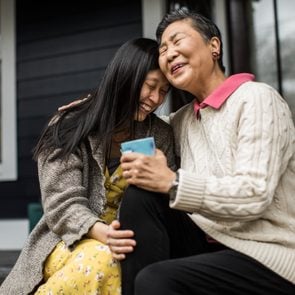Anyone will tell you that Butte, Montana, is tough. They'll also tell you that it's unbelievably kind.
The Montana Mining Town with a Heart of Gold

To see the best of Butte, Montana, all Joyce O’Bill has to do is look out her front window at the gleaming white Virgin Mary on the mountain.
“I look out every morning and say hi,” she says.
Perched high on a ridge outside of town, the massive statue known as Our Lady of the Rockies (or just Our Lady to locals) can be seen from almost everywhere in this famously hardworking city. Bob O’Bill built it as a tribute to his wife while she battled cancer. While Joyce was hard at work beating the disease, her husband’s modest vision of a 5-foot front-yard statue was blossoming into a 90-foot mountaintop memorial to both family and motherhood.
“Bob said, ‘I’m not religious, but I’ve got a lot of faith,’ ” says Joyce. “I tell everybody that it doesn’t have so much to do with me, or religion. It’s for all mothers.”
Joyce ended up outliving Bob: He passed away in 2016, and she’s still going strong at 90. So strong, in fact, that she drives twice weekly to the Butte Emergency Food Bank to give back to the community that has given so much to her.
“I started 31 years ago, and kept going and going. I’m the old one there,” she says. “When we started, it was only four of us. Now we have 60 or 70 volunteers.”
It’s people like her who inspire Lorraine Hamry most. A retired banker and Butte native, Hamry started volunteering at the Butte Emergency Food Bank a decade ago and is now its director.
“I’ve absolutely fallen in love with it. I had no idea how much Butte gives back,” says Hamry of one of Reader’s Digest‘s Nicest Places in America finalists. “People in Butte are so proud. They think everybody should know where Butte is. It’s not ‘Butte, Montana’—it’s ‘Butte, America.’ ”
Get Reader’s Digest’s Read Up newsletter for more inspiring stories, humor, cleaning, travel, tech and fun facts all week long.
Tough but kind
Founded in 1864 and once the largest city in the West, Butte has always been a rugged place. Joyce O’Bill still remembers when the local high school got its first turf field.

“The kids played on rocks and dirt for years,” she says. “When they finally put in grass for the football field, we thought we were big time.”
Now home to 35,000, Butte is most famous for its biggest scar: the mile-long crater on the east side of town known as the Berkeley Pit, or just “the pit,” a former open-pit copper mine almost 1,800 feet deep. The city was once among the world’s most important copper-mining regions. Workers created a tight-knit community that took care of its own.
“Everybody knew everybody,” recalls Hamry, 61. “People say they’re ‘Butte tough’—that’s because everyone here is surviving.”
Today, as mining gives way to tourism, Butte’s blue-collar workers have been joined by artists, professionals and entrepreneurs like Demetrius Fassas, a Kentucky transplant who moved to Butte in 2015.
“People who come here tend to want to create something for themselves, to start things,” says Fassas. “These people are hardy. They know how to do stuff. They’re survivors.”
Fassas, 34, came to Montana to ski, then stayed to build a career in service. In between, he has helped launch community gardens and two sober-living communities. He now runs the Covellite Theatre, named for the region’s signature copper-rich mineral. The Covellite hosts concerts, potluck suppers, open mics and fundraisers.
Curiously, Fassas has found that the less he asks for, the more he gets.
“We’ve had donation events that do better than ticketed events,” he says. “If you don’t put a price tag on it, people actually give more.”
Butte’s emphasis on community
A few blocks away at the Hungry Hill Center for Art, Education and Outreach, Butte native Mike Kujawa has found the same generosity. An art teacher at Butte’s high school, Kujawa wanted to support the food bank’s youth programs. So he and his students made simple bowls to fill with soup and sell at a fundraiser. Patrons would pay $20 for their meal and the bowl it came in. At the time, Kujawa, 57, had no idea how much support his Empty Bowls Project would generate.
“That first year, we made 650 bowls, and we were overwhelmed. We had just one soup line and so many people,” Kujawa recalls. “This year, we made 1,700 bowls and could only sell 1,300 tickets because that’s all the fire marshal would allow in the building.”
The support reflects a deep Butte tradition, Kujawa says.
“It goes back to the mines—there was no insurance. When somebody died in the mine or got injured, everybody got together to help the family,” he explains.
It’s that same Butte spirit that made the Our Lady of the Rockies statue possible.
When Bob O’Bill shared his modest plans with friends in 1979, they started thinking bigger. A supporter donated land. The mining company lent equipment. It took Bob and his friends five years to build the road to the ridgetop and pour the concrete base. The 51-ton statue was completed in 1985, its seven steel sections flown in by Nevada Air National Guard helicopters as locals cheered from below.
“So many good guys,” Joyce O’Bill recalls. “They’d all work their jobs all day, and then go up there at night and work some more. Then they’d come down all hungry and dirty and sit in the front room and giggle.”
A shrine at the site includes 15,000 memorial tiles for mothers and grandmothers. One tile honors the great-grandmother of Butte native Shannon Hopewell.
“The view is spectacular—you can see the Berkeley Pit, the city, everything,” says Hopewell.
A resilient spirit
Our Lady of the Rockies isn’t Butte’s only statue of note. Outside the town archives, where Hopewell works, stands a bronze-and-stone memorial to a true Butte survivor—the famously standoffish stray dog known as the Auditor, who spent 17 years living alone at the Berkeley Pit.
“The number of people who stop by to pat his head is amazing,” says Hopewell.
Miners named the dog the Auditor because he’d show up when least expected. He wouldn’t let anyone near him, but miners left him food and built him a doghouse, where he would eventually pass away peacefully.
The story captivated Hopewell, 32, who recently published a children’s book about him called The Richest Dog on Earth.
“We don’t really know where he came from, but the miners took care of him,” Hopewell says. “There’s a resilience to the people of Butte. Even if you’re alone, you can still find a friend.”
The city isn’t perfect, says Fassas: “Nine months of winter is tough.”

But Butte has held on to its history and builds its future.
Visitors can see the World Mining Museum, hit the Montana Folk Festival and eat at the nation’s oldest Chinese restaurant, the Pekin Noodle Parlor, founded in 1911. There’s a film festival, the country’s most difficult 100-mile mountain bike race, and a two-day Fourth of July party (Butte’s title as Montana’s “festival city” is certainly earned). And the spectacular landscape around the city offers hiking, biking, hunting, fishing and any winter sport you can think up.
The longer you stay, claims Kujawa, the harder it is to leave.
“You will see a rough edge,” he says, “but they’re the friendliest people around. What else is there to say?”
Why trust us
For more than 100 years, Reader’s Digest has been known for its heartwarming true stories and focus on community. In 2016, we launched the Nicest Places in America, an annual contest that honors kind, inspiring people making a difference in their hometowns. Readers send in nominations, and Reader’s Digest’s editorial team vets the entries and whittles them down with the help of a panel of judges. This year, the judges included Today’s Al Roker, Tuesdays with Morrie author Mitch Albom, author and podcast host Mónica Guzmán, award-winning journalist and author Steve Petrow, Reader’s Digest CEO Bonnie Kintzer, and Craig Elston, a barber who helped Buffalo, New York, earn the title of Nicest Place in America in 2023. We are committed to producing high-quality content by writers with expertise and experience in their field in consultation with relevant, qualified experts. Read more about our team, our contributors and our editorial policies.


